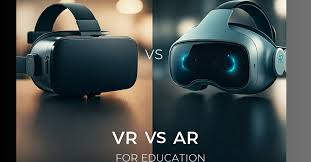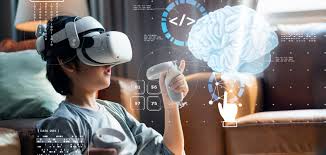Field trips have long been a cherished part of education, offering students the chance to experience learning outside the classroom. From museums to historical sites, these excursions make lessons come alive. But in today’s digital age, the concept of field trips is evolving. Thanks to Virtual Reality (VR) and Augmented Reality (AR), students can now explore distant lands, dive into the ocean, or even travel back in time—all without leaving their school. Let’s delve into how these groundbreaking technologies are revolutionizing field trips and reshaping education.
What Are VR and AR?

Understanding Virtual Reality (VR)
Virtual Reality immerses users in a fully digital environment. By wearing VR headsets, learners can step into 3D simulations of real or imagined worlds.
What Is Augmented Reality (AR)?
Unlike VR, AR overlays digital content onto the real world. With AR, learners use smartphones, tablets, or AR glasses to interact with virtual elements integrated into their surroundings.
Why Traditional Field Trips Face Challenges
Field trips, though valuable, often come with limitations:
- Cost: Transportation, tickets, and supervision can make trips expensive.
- Logistics: Organizing field trips for large groups can be challenging.
- Accessibility: Remote locations or historical sites may be off-limits for many schools.
Enter VR and AR: The New Age of Field Trips
VR and AR bridge these gaps, offering immersive, accessible, and cost-effective alternatives to traditional field trips. Here’s why these technologies are gaining traction:
1. Breaking Physical Barriers
Why stop at the local museum when you can tour the Louvre in Paris? VR eliminates geographical restrictions, allowing students to explore places they could never visit in person.
2. Enhancing Engagement
With VR and AR, students don’t just learn—they experience. Imagine studying marine biology by swimming alongside dolphins or exploring ancient Rome while walking its streets.
3. Cost-Effective Solutions
Virtual field trips require only a one-time investment in technology, reducing the recurring costs associated with traditional trips.
How VR and AR Are Transforming Field Trips
1. Virtual Museum Tours
Students can virtually visit world-renowned museums like the Smithsonian or the British Museum. These VR tours often include interactive elements, such as clickable artifacts with detailed descriptions.
2. Historical Time Travel
AR apps allow students to witness historical events as if they were there. For example, learners can watch the signing of the Declaration of Independence unfold before their eyes.
3. Exploring the Natural World
With VR, students can trek through the Amazon rainforest or climb Mount Everest, all from their classroom seats. AR apps can bring extinct animals to life, offering a glimpse into prehistoric times.
4. Space Exploration
Using VR, students can journey through the solar system, walking on the surface of Mars or floating inside the International Space Station.
Benefits of VR and AR Field Trips
1. Immersive Learning
VR and AR create multisensory experiences, helping students retain information more effectively.
2. Accessibility for All
Virtual field trips make learning opportunities available to schools with limited budgets or students with disabilities.
3. Customizable Experiences
Educators can tailor virtual trips to align with lesson plans, focusing on specific topics or concepts.
4. Real-Time Interaction
AR enables real-time engagement, such as identifying plants during a virtual nature hike or solving puzzles in an archaeological dig.
Popular Tools and Platforms for VR and AR Field Trips
1. Google Expeditions
Google Expeditions offers VR and AR tours on topics ranging from science to history. Teachers can guide students through virtual experiences using smartphones or VR headsets.
2. Nearpod VR
This platform provides interactive VR lessons, covering everything from anatomy to world geography.
3. Discovery Education VR
Discovery Education offers immersive VR experiences that bring science, history, and culture to life.
4. HoloLens by Microsoft
Microsoft’s HoloLens blends AR with real-world settings, offering interactive learning opportunities.
Challenges and Considerations
1. Cost of Technology
While VR and AR are more cost-effective in the long run, the initial investment in devices and software can be high.
2. Digital Literacy
Teachers and students may need training to effectively use these technologies.
3. Potential for Distraction
The immersive nature of VR and AR can sometimes lead to students losing focus on educational objectives.
How Educators Can Integrate VR and AR into Learning
1. Start Small
Begin with affordable options like Google Cardboard or AR mobile apps to introduce the concept to students.
2. Align with Curriculum
Choose VR and AR experiences that complement your lesson plans, ensuring the technology adds value to learning.
3. Encourage Collaboration
Pair students to work together on VR or AR projects, fostering teamwork and problem-solving skills.
4. Evaluate Effectiveness
Gather feedback from students to assess how VR and AR impact their learning experience.
The Role of Gamification in VR and AR Field Trips
Adding gamification elements, such as rewards, challenges, or leaderboards, can make virtual field trips even more engaging. For example:
- A VR archaeological dig could challenge students to uncover hidden artifacts.
- An AR science lesson might include quizzes that unlock new virtual environments.
Success Stories: VR and AR Field Trips in Action
1. Bringing History to Life in California
A school in California used VR to take students on a tour of the ancient Egyptian pyramids. The immersive experience allowed students to explore tombs and learn about mummification firsthand.
2. Ocean Exploration in Florida
Marine biology students in Florida used VR to dive into the Great Barrier Reef, observing coral ecosystems and endangered species.
3. Space Adventures in Texas
A Texas school integrated VR into its astronomy curriculum, letting students virtually walk on the moon and visit distant planets.
The Future of VR and AR Field Trips
1. AI-Powered Personalization
Future VR and AR platforms will adapt to individual learning styles, offering personalized experiences.
2. Global Collaboration
Students from different countries could join the same virtual field trip, fostering cross-cultural learning.
3. Mixed Reality (MR)
Combining VR and AR, mixed reality will offer even more interactive and immersive educational opportunities.
How VR and AR Support Lifelong Learning
Beyond K-12 education, VR and AR are transforming professional development and adult learning. For instance:
- Medical Training: VR allows medical students to practice surgeries in a risk-free environment.
- Corporate Learning: Companies use VR for employee training on safety protocols and soft skills.
Conclusion
Virtual and augmented reality are not just enhancing field trips—they’re redefining them. By breaking down geographical, financial, and logistical barriers, VR and AR offer students unparalleled learning experiences. As these technologies continue to evolve, the possibilities for education are endless. So, the next time you think about a field trip, why not go beyond the classroom and explore the virtual world?
FAQs
1. What is the main difference between VR and AR?
VR creates a fully immersive digital environment, while AR overlays digital elements onto the real world.
2. Are VR and AR field trips expensive?
While there’s an initial investment in technology, they are more cost-effective than traditional trips in the long run.
3. Can virtual field trips replace physical ones?
While they can’t fully replicate the sensory experience of physical trips, they offer unique benefits like accessibility and flexibility.
4. What subjects are best suited for VR and AR field trips?
Subjects like science, history, geography, and art benefit greatly from immersive VR and AR experiences.
5. Do students need special equipment for VR and AR field trips?
For VR, a headset is often required. AR can typically be accessed via smartphones or tablets


